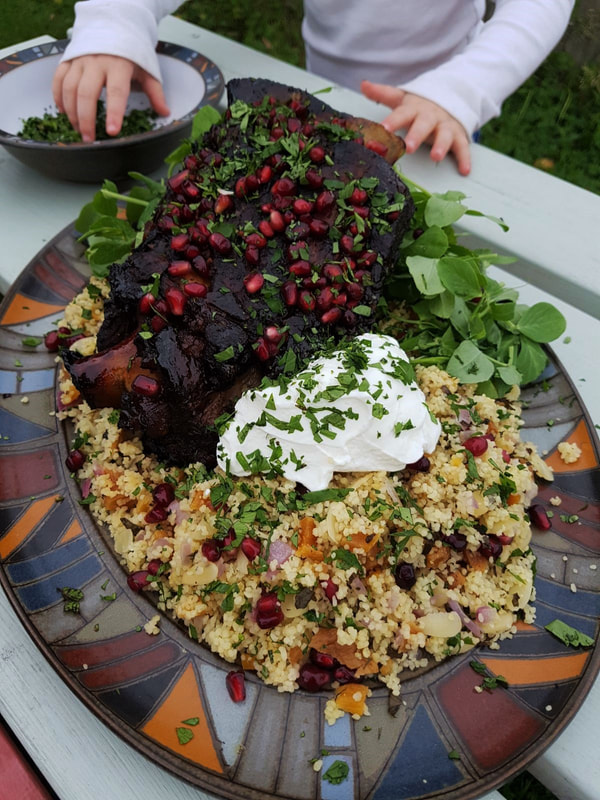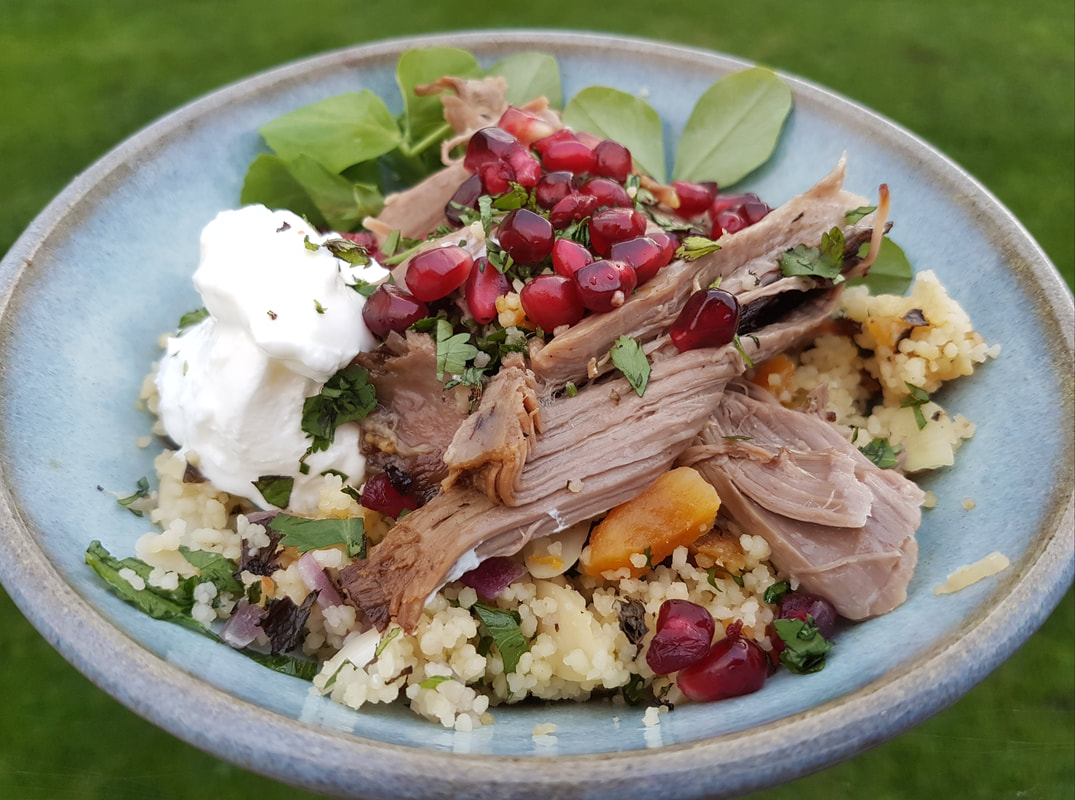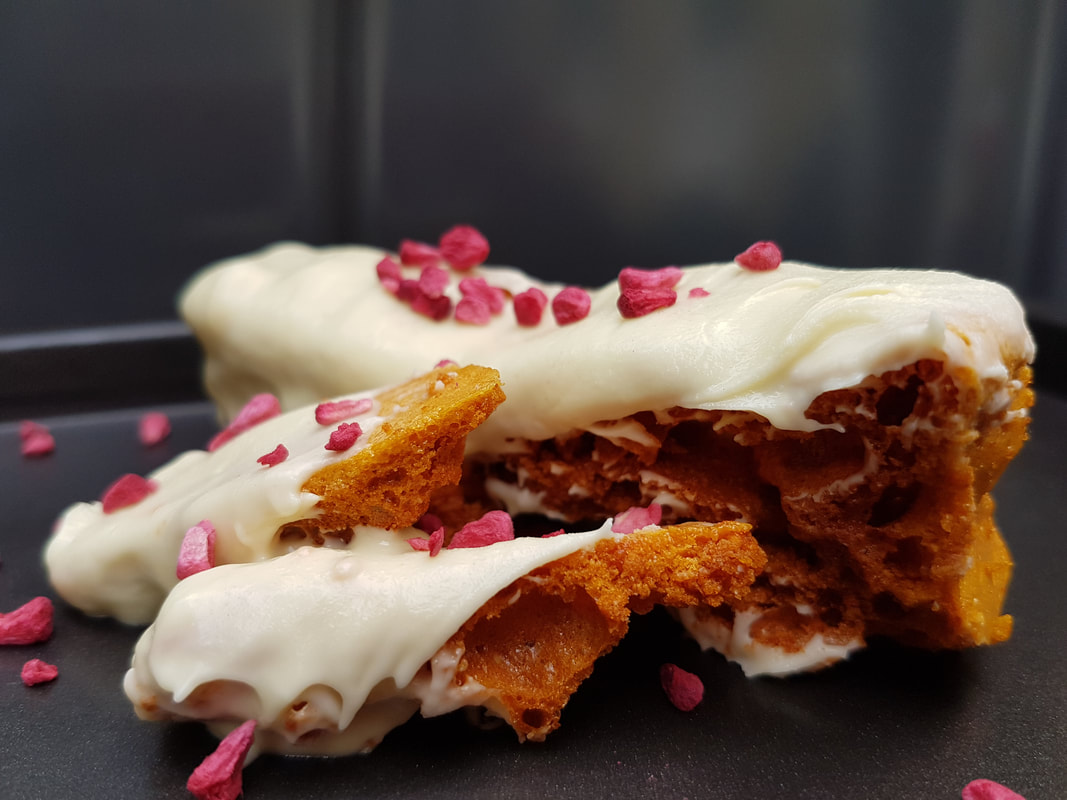|
Recreated from Spellslinger by Sebastien de Castell [He] came and set the tray down on the small desk in the corner of my room and sat at the chair that was already too small for me and made him look like a giant. He lifted the red-clay cover from the tray, revealing a plate laden with some kind of roasted lamb dish that smelled wonderful. 'The family has already been served ... This is my supper and I'm entitled to eat it where I please.' 'You want to eat in my room?' 'Do you mind?' I got up from the bed, my clothes from the day before feeling rough and stiff against my skin, and joined him at the desk. When I looked at the tray I noticed he'd put together a rather large portion for one man. I noticed something else as well. 'You seem to have two sets of cutlery on your tray.' I have the pleasure of providing milk for a growing baby, so it was my husband who popped to London for Fantasy in the Court at Goldsboro Books. My gift from the last event he went to was a note from Robin Hobb in our copy of Assassin's Apprentice. My gift this time was an answer from Sebastien de Castell to, 'Which dish from any of your books should we attempt to recreate?' The answer: Spellslinger roasted lamb. I'd been meaning to read Spellslinger for some time as an interlude between Saint's Blood and Tyrant's Throne (I'm saving that last one of the Greatcoats for a special treat) so the search for lamb gave an added incentive. I found the lamb (excerpt above) and enjoyed thinking about food-sharing as an act of defiance throughout the book. Although we're not told exactly what kind of roasted lamb dish this is (I appreciate it's not the most important thing going on here) I've taken the liberty of borrowing ingredients mentioned elsewhere in Spellslinger. There's a traditional Jan'Tep spirit called dzajil that's made with apricots and pomegranates, and both these ingredients are eminent companions for roasted lamb. Even though Sebastien de Castell describes the lands of Spellslinger as 'more akin to the American frontier,' there seem to be Persian or Arabic influences at play, so that's what I've gone with. The amount I cooked surpasses even 'a rather large portion for one' so I'd recommend four to six sets of cutlery. Or you can do what we did and enjoy the leftovers the next day – it's just as nice cold as it is hot. Lamb (for four generous portions)
Lamb marinade
Couscous (for four generous portions)
To serve
1. Preheat oven to 150°C (300°F) fan. 2. Place the chopped white onions in the bottom of a casserole dish. 3. Mix all the marinade ingredients in a bowl except for the boiling water. There's a tidy ratio so you can scale up or down depending on the size of your lamb joint. 4. Rub the marinade all over the lamb, including over the fat cap. Place on top of the onions in your casserole dish, fatty side up. Pour the boiling water into your marinade bowl to catch any that got left behind and then pour it around the lamb but not on it. 5. Cover and cook in the oven for two hours (or one hour per 500g of lamb). While the lamb is cooking, prepare the couscous. ~ 6. Heat the oil on medium in a frying pan until it spreads around easily when tilted. 7. Add the diced red onion, apricots and almonds and fry over a medium heat for five minutes, stirring occasionally to stop anything catching. 8. Remove the apricot mix from the heat. Prepare your stock. 9. Add the dried couscous to the apricot mix along with the parsley and mint. Stir to combine thoroughly. Pour over the stock making sure that all the couscous is covered. Cover and set aside until ready to serve. Fluff the couscous with a fork before serving. ~ 10. Take your lamb out of the oven after the allocated time and remove the lid or foil. Spoon over the juices from the bottom of the dish. Return to the oven uncovered and cook for a further 15 minutes. Remove the dish from the oven, then remove the lamb and leave it to rest for 15 minutes. Serve whole as part of a sharing platter or 'carve' (the meat will be tender enough to pull from the bone by hand) if serving in individual portions. ~ 11. To serve – whether as a platter or in individual portions – build the dish up in layers: leafy greens on the bottom / off to one side, then apricot couscous, then lamb, then pomegranate seeds. Finish with a good dollop of yoghurt and sprinkle with the fresh mint and parsley. Tl;dr
1 Comment
Inspired by John Gwynne's Malice [Thannon] 'I need you to strike for me. Torin has asked for half a dozen scythes.' He looked at Corban, who was still leaning against the doorframe. 'Now, lad. We have to draw this iron out before it cools.' Corban slipped his pitted leather apron on and took the hammer that Thannon was waving at him. A thick length of iron was held in long tongs on the anvil, glowing white hot, a dark honeycomb running through it. Corban knew what to do, and the hammer began to ring as he beat the metal, incandescent sparks flying as impurities were slowly coaxed and beaten from the iron. There's been some debate in the Speculative Kitchen over whether food metaphors are strong enough grounds for a recipe, so I'll acknowledge now just how loose I'm being with my 'inspired by'. John Gwynne does make the smithy sound like a rather tasty place to be though. And making honeycomb is probably the closest I'll get to blacksmithing any time soon – you have to work very quickly before the hot mixture cools down. After that, it's a straightforward matter of breaking up the cooled honeycomb, dipping the bars into melted chocolate and scattering with your preferred impurities. (To feed half a dozen)
For the honeycomb
Preparation 1. Fill a bowl with cold water. You'll be dropping a small amount of the caramelised sugar into it at step 5. 2. Put the bicarbonate of soda into a bowl. You'll need to add this to the caramelised sugar in one go at step 6. By this point you'll also have to work faster than you read, so take the time now to familiarise yourself with the cooking instructions. 3. Line a 20x20cm brownie tin or 23cm cake tin* with greaseproof paper. You'll pour your hot honeycomb mixture into it at step 7. *This gives thick pieces of honeycomb. You could use a bigger tin for thinner honeycomb. Make the honeycomb 4. Add the sugar and golden syrup to a saucepan and place on a medium heat. Bring the sugar and syrup to the boil and then reduce the heat to low to simmer. 5. Stir the caramelising sugar regularly to make sure it isn't catching*. After around eight minutes when the mixture is molten, drop a small amount into your pre-prepared bowl of cold water. If it sets hard almost instantly (you can pluck it out to check**) the caramelised sugar is ready to be removed from the heat. If not, continue to simmer and check at one-minute intervals. * Burning the sugar will make your honeycomb bitter. **It's only OK to do this because the mixture has been plunged in cold water; it's otherwise far too hot to touch. 6. Remove the caramelised sugar from the heat, add the bicarbonate of soda all in one go and stir. The sugar will react right away – bubbling up to around four times its starting height – so you must stir immediately and vigorously until the bicarbonate of soda is evenly distributed. 7. Quickly pour the honeycomb mixture into your pre-prepared tin. Give it a tilt if you need to help fill the tin but don't try to spread it around; it only gets messy. Leave to cool. 8. When the honeycomb has cooled down (this only takes a few minutes) remove from the tin and peel away the greaseproof paper. Break into pieces by hand or carve up with a knife. You'll get all sorts of shapes and sizes. Add the chocolate 9. Break the chocolate into pieces and place in a dry heatproof bowl. The bowl should be just the right size to sit atop your saucepan (a snug fit around the top of the bowl is best). 10. Bring an inch of water to boil in your saucepan and then reduce the heat to low to simmer. Place the bowl of chocolate onto the saucepan, making sure that the bottom of the bowl doesn't come into contact with the water. 11. Stir the chocolate as it melts and remove from the heat just before the last pieces have finished melting. White chocolate seizes easily so you don't want to overdo it on the heat. 12. Dip your honeycomb pieces into the bowl of melted chocolate or spoon and spread the chocolate over your honeycomb pieces – whichever you find easier. To serve 13. Sprinkle your chosen 'impurities' over the top. Short and sweet version
|





 RSS Feed
RSS Feed